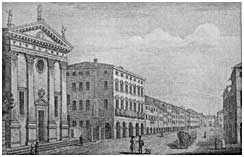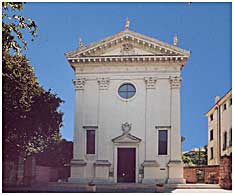|
 |
|
| THE CHIESA DI SANT’AGNESE (CHURCH OF ST. AGNES), Borgo Cavour - Treviso |
| |
In the history of Treviso the presence of an ancient church dedicated to
St. Agnes is reported before 1268, it was situated in front of the present Collegio Vescovile Pio X many centuries ago.
In 1529 the Pope Leone X gave the Lateran Canons this first church by an appropriate decree of his; the Lateran
Canons were been received inside the Walls of Treviso only during the war of Cambrai.
In fact their old church, dedicated to Santi Quaranta (Forty Saints), was located in the zone of San Giuseppe, this church was
built for will of the bishop Odorico III and then it was destroyed in 1518. |
| |
|

Chiesa di Sant’Agnese - 1846 Antonio Nani’s engraving. (Biblioteca Comunale in Treviso)
|
 |
The Lateran Canons built the cloister in the
place where today there is the present Istituto Besta; they raised also the church dedicated to Santi Quaranti (Forty Saints).
In 1613 this church was built again by Andrea Pagnossin’s plans, according to Federici, and it was often
attributed to Palladio due to its harmonious style.
When the Lateran Canons left Treviso, the Complex was guarded
by the Cathedral Canons; thus in 1778, when the first Chiesa di Sant’Agnese (Church of St. Agnes) was demolished, its name went to Chiesa di Santi Quaranta (Church of Forty Saints). |
| |
|
Indoor the church it is possible to see interesting
and artistic works as the Trevisan Ascanio Spineda’s painting made in the 16th century, Antonio Pieri’s canvas,
called "lo zoppo" (the lame person), made in the 18th century and the Francesco Maggiotto’s painting, made in the
18th century.
The present marble floor has Gothic motifs and it took the place of the original floor lately.
The fašade of the Church of St. Agnes has four pilasters with Corinthian motifs outside; above the fašade there
is a triangular pediment which holds statues of St. Giovanni Battista, of Redentore (Redeemer) and of St. Agnes. |
| |
The church inside, as other smaller churches of
Treviso, has a single nave emphasized by pilasters with Corinthian motifs, which have Doric capitals on the top.
There are two altars, located on every side of the church sideways and there is the main frontal altar, which has
baroque motifs; all the altars are made by many different marbles, by inlays and by cherubs situated above their
volutes. On the first right altar the ancona represents the martyrdom of St. Agnes; the last studies confirm the fatherhood
given, in the past centuries, to Antonio De Pieri, called "the zoppo". |
 |
 Chiesa di Sant’Agnese
Chiesa di Sant’Agnese |
|
| |
| |
| In the second right altar you may see a late canvas
with "Madonna con bambino" (Madonna with a child) by Giulio Erler, then on the left altars from the entrance there
are the representation of St. Ubaldo (who are releasing a demoniac woman) and near the main altar a representation
of Redentore (Redeemer) who is blessing. Different colorful marbles emphasize the beauty of main altar, located
behind a parapet adorned by two angels in Istrian stone. |
| |
On the background the ancona by Ottavio Cocchi,
representing martyrdom of Santi Quaranta (Forty Saints), is adorned by a cornice made in 1729, improved by
stuccos, caryatids and angels.
Other interesting works are the wooden confessional and the wooden chancel,
made by skilful local craftsmen in the 18th century and the two-manual organ.
|
|


